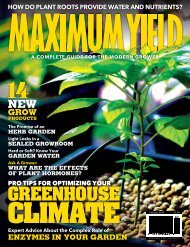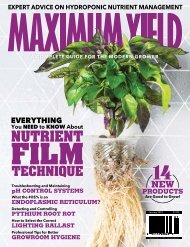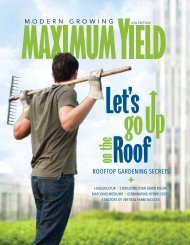Maximum Yield Canada July/August 2017
While hydroponics is unlikely to overtake traditional agriculture economically anytime soon—current US annual crop production is estimated at $143 billion while hydroponics is valued at a mere $600 million—it’s not so much as how much is being grown but where. Today, nobody knows what society will be like in 2100. We hope it will be a peaceful, healthy, and happy place.
While hydroponics is unlikely to overtake traditional agriculture economically anytime soon—current US annual crop production is estimated at $143 billion while hydroponics is valued at a mere $600 million—it’s not so much as how much is being grown but where. Today, nobody knows what society will be like in 2100. We hope it will be a peaceful, healthy, and happy place.
You also want an ePaper? Increase the reach of your titles
YUMPU automatically turns print PDFs into web optimized ePapers that Google loves.
grow cycle<br />
grow tent growing<br />
“<br />
SUPER<br />
GROWING ”<br />
by Alan Ray<br />
Ok, while perhaps not the most intense form<br />
of gardening, housing plants in tents is fast<br />
becoming one of the more popular ways to grow.<br />
Here’s a basic overview of what this style of<br />
gardening entails and how you can get started.<br />
The most common definition of the word “tent” begins<br />
with these three words: a portable shelter. While simple,<br />
the description is accurate. Grow tents provide simple and<br />
portable solutions for those with limited space or who prefer a<br />
more private environment. These attributes are also why grow<br />
tents are fast becoming one of the most popular ways to grow.<br />
What is a Grow Tent?<br />
At its core, a grow tent is like a wigwam with a zipper,<br />
though admittedly a bit higher tech and with a few more<br />
bells and whistles. They are generally square or rectangular<br />
and constructed of lightweight nylon or cloth. The standard<br />
grow tent is framed by poles that are usually coated<br />
metal or made of PVC pipe. The entire interior is lined with<br />
a highly reflective material and comes with precut ports to<br />
allow for ventilation and exhaust fan installation. Lights<br />
can be suspended from above.<br />
Grow tents can accommodate all types of growing methods,<br />
including hydroponics and good ol’ pots of soil. (Aquaponics,<br />
however, is best suited for an open room.) Key advantages of<br />
a grow tent are your garden is protected from pests and the<br />
elements, and access to your plants is just a zip away.<br />
Size Matters<br />
The size of your tent is important, but bigger isn’t always better<br />
for beginners. Smaller tents are easier on the budget and a<br />
good way to test the waters without breaking the bank. They<br />
also take up less room and are easier to work in, even though<br />
they possess many of the features a big tent does. Plus, you can<br />
always go bigger later after you gain some experience.<br />
A good size to start with is a 2x4-foot or 4x4-foot tent. Either<br />
can grow and sustain a nice little garden while allowing for<br />
easy access to your plants and accommodating standard<br />
lighting requirements.<br />
What You Need Inside<br />
Above and beyond what the tent manufacturer supplies, you’ll<br />
need to purchase lights, ducting, timers, power strips, and<br />
extension cords. You’ll also need soil and fertilizers, which<br />
should be plant-specific.<br />
40 grow cycle

















